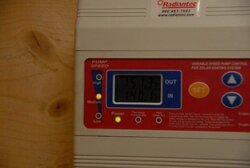. system? I understand with a solar DHW system there are losses with a heat exchanger, and that it's size is crucial to handing off heat the best. However- with a drainback system, my big reservation is containing the water that drains back and if the system turns on and of repatedly on a day then that water will add up. Is there some way to pipe it back into the intake side of the water heater so I don't conciously have to go empty out the water, or something similair? And just how big of a water heater can I get away with on 2 collectors on a drainback system? I'm pretty sure that 30 gal. is tops with a closed/ pressurized system................
Drainback or closed loop..........
- Thread starter WoodMann
- Start date
-
Active since 1995, Hearth.com is THE place on the internet for free information and advice about wood stoves, pellet stoves and other energy saving equipment.
We strive to provide opinions, articles, discussions and history related to Hearth Products and in a more general sense, energy issues.
We promote the EFFICIENT, RESPONSIBLE, CLEAN and SAFE use of all fuels, whether renewable or fossil.


 ).
). 